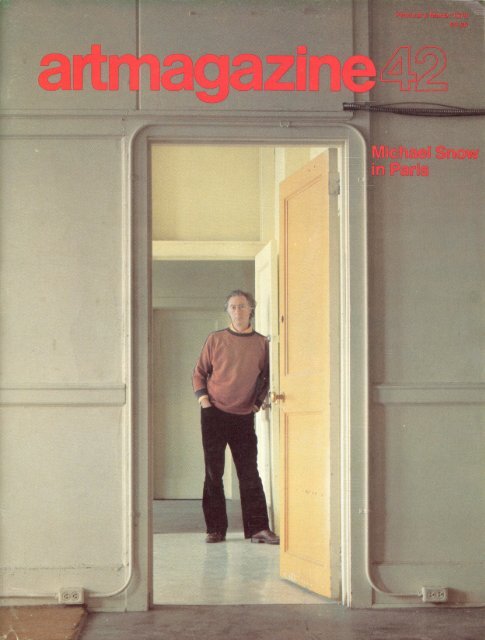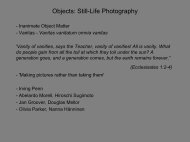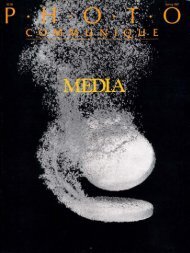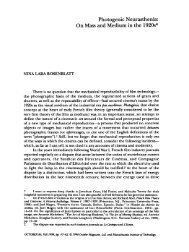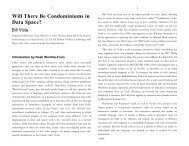Faces and Facades - School of Image Arts
Faces and Facades - School of Image Arts
Faces and Facades - School of Image Arts
Create successful ePaper yourself
Turn your PDF publications into a flip-book with our unique Google optimized e-Paper software.
Photography<br />
<strong>Faces</strong> <strong>and</strong> <strong>Facades</strong><br />
by Don Snyder<br />
OPPC<br />
counery Polaroid Corporation.
<strong>Faces</strong> <strong>and</strong> <strong>Facades</strong>lcontinued<br />
<strong>Faces</strong> <strong>and</strong> <strong>Facades</strong> is the apt title <strong>of</strong> a<br />
book recently published by the Polaroid<br />
Corporation to showcase photographs<br />
made with Polaroid's new 8 x 10 color film.<br />
Designed, according to the book jacket,<br />
"for the viewer's contemplative joy", it<br />
contains 43 images by sixteen photographers:<br />
Ray Belcher, James Bones.<br />
Elisabetta Catalano, Marie Cosindas, Alma<br />
Davenport Dailey, Carl Fischer, Paul Huf,<br />
Peter Jones, Yousuf Karsh. Ulrich Mack.<br />
Arnold Newman, lnge Reeth<strong>of</strong>, Gunter<br />
Sachs, Stephen Shore, Christian Vogt, <strong>and</strong><br />
Reinhart Wolf.<br />
The book makes an immediate impression.<br />
The problems that plagued early 4 x 5<br />
Polaroid color materials (unpredictable<br />
color shifts, inconsistent emulsion speed,<br />
awkward tone reproduction in very high or<br />
very low contrast light) <strong>and</strong> the first SX-70<br />
film (which until recently was even less<br />
predictablethan the original 4 x 5 Polacolor)<br />
have been reduced to acceptable<br />
levels or eliminated in this new 8 x 10<br />
emulsion. The photographers were carefully<br />
chosen to give a broad spectrum <strong>of</strong><br />
image styles <strong>and</strong> demonstrate the new<br />
film's versatility, brilliance, <strong>and</strong> color fidelity<br />
as effectively as possible. And the photographs<br />
are superbly reproduced. Printed<br />
on Bcolor presses from laser-scan color<br />
separations, the reproductions represent<br />
state-<strong>of</strong>-the-art color printing in North<br />
America at this time.<br />
<strong>Faces</strong> <strong>and</strong> <strong>Facades</strong> begins with<br />
Elisabetta Catalano's photographs <strong>of</strong><br />
Italian film directors: pleasing studio portraits<br />
made by electronic flash, with the<br />
subjects posed simply in front <strong>of</strong> seamless<br />
backgrounds..Whilethese areskilful images,<br />
many fail to engage the viewer more<br />
than momentarily - a very interesting<br />
portrait <strong>of</strong> Federico Fellini excepted.<br />
Polaroid's choice<strong>of</strong> adisconcertingly smug<br />
Franco Rosi as one <strong>of</strong> the portraits reproduced<br />
on the book jacket seems somewhat<br />
curious; it is not spontaneous enough to<br />
work as a snapshot, <strong>and</strong> not subtle enough<br />
to be a really insightful portrait.<br />
Catalano's work is followed by three<br />
Stephen Shore images, made in Europe.<br />
<strong>and</strong> possessed <strong>of</strong> the grace <strong>and</strong> poise one<br />
has come toexpect <strong>of</strong> Shore's large-format<br />
color work. An image <strong>of</strong> six empty chairs in<br />
front <strong>of</strong> aswimming pool in southern France<br />
is particularly fine. One regrets that more<br />
space was not given to Shore, who is a<br />
remarkable photographer.<br />
Alma Davenport Dailey, a young photographer<br />
from Rhode Isl<strong>and</strong>, is represented<br />
by three manipulated collage<br />
photographs. Many photographers are exploring<br />
thevisual <strong>and</strong> symbolic possibilities<br />
<strong>of</strong> collage, h<strong>and</strong> coloring, combining snapshots<br />
with contemporary images, <strong>and</strong> the<br />
like, so Dailey's themes are not entirely<br />
original. There is a pleasant nostalgiato her<br />
work but one image would suffice; the<br />
second photograph seems an overly obvious<br />
statement about widowhood, the third<br />
an awkwardly colored "lost childhood"<br />
generic image.<br />
Carl Fischer's work should be recognized<br />
by anyone who has followed<br />
Polaroid's publicity campaign for 8 x 10<br />
Polacolor, <strong>and</strong> his one image is beautifully<br />
sleek. Likewise Reinhart Wolf's images<br />
have been seen in the company's posters<br />
<strong>and</strong> brochures. His photographs <strong>of</strong> rural<br />
Georgia are subdued <strong>and</strong> very beautiful.<br />
but they lack the authority <strong>of</strong> Shore's best<br />
work <strong>and</strong> are not well presented here.<br />
A brilliant blue border around twovery<br />
still images is overly jarring, <strong>and</strong> the sequencing<br />
<strong>and</strong> sizing <strong>of</strong> the pictures seems<br />
arbitrary.<br />
Christian Vogt's figure studies owe a<br />
clear debt to Magritte, but in spite<strong>of</strong> this are<br />
quitesuccessful. An image <strong>of</strong> a darkskinned<br />
man holding a red cloth in front <strong>of</strong><br />
his torso is especially strong. The man<br />
st<strong>and</strong>s in a dark, ambiguous space; his<br />
head is not shown <strong>and</strong> a mirror on the floor<br />
reflects part <strong>of</strong> the red cloth. A tone<br />
resonance is set up between the red cloth<br />
<strong>and</strong> the background (dark green-brown)<br />
that is remarkable, particularly when viewing<br />
the book in subdued light. Ulrich Mack.<br />
another European photographer, is represented<br />
by l<strong>and</strong>scapes which deal with<br />
flatness, distance, horizon, explicitly stated<br />
vanishing points, <strong>and</strong> saturated color.<br />
These are good images, reminiscent <strong>of</strong><br />
work by l<strong>and</strong>scape-as-sculpture/l<strong>and</strong>scape-as-concept<br />
photographers such as<br />
Lewis Baltz or John Pfahl. Mack's portrait <strong>of</strong><br />
a middle-aged couple in front <strong>of</strong> their<br />
cottage is not as effective as the images<br />
that precede it <strong>and</strong> seems like an afterthought.<br />
Peter Jones' bluelred figure-ground<br />
studies (done with models <strong>and</strong> body paint)<br />
are startling. They possess some <strong>of</strong> the<br />
same color resonance as Vogt's best work<br />
<strong>and</strong> much <strong>of</strong>thesleekness <strong>of</strong> Carl Fischer's<br />
images. Like many <strong>of</strong> the photographers in<br />
<strong>Faces</strong> <strong>and</strong> <strong>Facades</strong>, Jones also owes a<br />
Stylisticdebt: his is to Eikoh Hosoe's<br />
"Embrace"series <strong>of</strong> photographs. Even so.<br />
the pictures are unusual <strong>and</strong> the blue <strong>and</strong><br />
red tones the film gives are little short <strong>of</strong><br />
incredible.<br />
Paul Huf is represented by tw<strong>of</strong>ashionable,<br />
slightly decadent haut monde<br />
photographs. One is a disturbing portrait<strong>of</strong><br />
a man dressed in white (baggy satin pants.<br />
white shirt, white jacket with heavily decorated<br />
shoulders <strong>and</strong> wrists) holding himself<br />
in a too-controlled posture in a too-skilfully-decorated<br />
interior; the other is a shot<br />
<strong>of</strong> a model, draped in plastic, st<strong>and</strong>ing in a<br />
hard-to-define high-key space decorated<br />
with plastic, clear glass balls, white garl<strong>and</strong>s<br />
<strong>of</strong> artificial flowers, <strong>and</strong> made more<br />
ambiguous with mirrors.<br />
Many other photographers have work<br />
reproduced in this volume. Yousuf Karsh is<br />
represented by a portrait <strong>of</strong> Arthur Fiedler;<br />
Arnold Newman, by a portrait <strong>of</strong> photographer<br />
Eva Rubinstein (not one <strong>of</strong> his<br />
best); lnge Reeth<strong>of</strong>, by a flower still-life;<br />
Gunter Sachs, by two mediocre shots <strong>of</strong><br />
nearly-nude women; James Bones, by<br />
three large-format l<strong>and</strong>scapes (in the tradition<br />
<strong>of</strong> Eliot Porter <strong>and</strong> Philip Hyde). Marie<br />
Cosindas has two photographs in <strong>Faces</strong><br />
<strong>and</strong> <strong>Facades</strong>, but her work is disappointing.<br />
She was one <strong>of</strong> the first photographers<br />
to draw widespread attention to the expressive<br />
possibilities <strong>of</strong> 4 x 5 format Polacolor,<br />
but her recent work suffers by comparison<br />
to the images that appeared in Saturday<br />
Review <strong>and</strong> on the walls <strong>of</strong> the Museum <strong>of</strong><br />
Fine <strong>Arts</strong> in Boston a dozen years ago. Her<br />
still life is overly busy, her one portrait quite<br />
stiff, <strong>and</strong> both pictures lack the painterly<br />
color <strong>of</strong> her early work. Finally, Ray Belcher<br />
is represented by two photographs, one <strong>of</strong><br />
which (a view <strong>of</strong> a bridge over the Rio<br />
Gr<strong>and</strong>e at dusk) is very well done.<br />
In the long run the very elements that<br />
make <strong>Faces</strong> <strong>and</strong> <strong>Facades</strong> so impressive at<br />
first glance contribute to the fact that the<br />
book does not st<strong>and</strong> up well to repeated<br />
viewings. The selection <strong>of</strong> photographers<br />
does encompass a wide variety <strong>of</strong> approachest08<br />
x lOcolor, with theresultthat<br />
a tantalizing number <strong>of</strong> uses for Polaroid's
new film immediately suggest themselves<br />
to any viewer with a knowledge <strong>of</strong> largeformat<br />
technique. But the book does not<br />
havea real stylisticorthematic focus. While<br />
one can put different, even unrelated work<br />
into an exhibition <strong>and</strong> still arrange a<br />
presentation which will form a coherent<br />
whole, any tack <strong>of</strong> continuity or unity in a<br />
book can pose a real problem. And both<br />
Polaroid <strong>and</strong> the represented photographers<br />
"play safe" too much <strong>of</strong> the time.<br />
Thereare morederivative images in <strong>Faces</strong><br />
<strong>and</strong> <strong>Facades</strong> than there should be, especially<br />
given the talent involved. Too many<br />
photographers adopt themes or stylistic<br />
devices from other photographers or painters,<br />
<strong>and</strong> three - Cosindas. Karsh, <strong>and</strong><br />
Newman - end up almost imitating themselves.<br />
Polaroid as a corporation scrupulously<br />
avoids taking any real risks, as they<br />
might have by supplying 8 x 10 Polacolor<br />
to photographers such as Lucas Samaras.<br />
Les Krims. Robert Cumming, Linda connor.<br />
Ed Ruscha, Paul Diamond. Guy<br />
Bourdin, or Berndt <strong>and</strong> Hilla Becher <strong>and</strong><br />
then publishing some <strong>of</strong> the results. Krims<br />
<strong>and</strong> Samaras have done powerful <strong>and</strong><br />
provocative work with SX-70 images.<br />
Robert Curnming <strong>and</strong> Linda Connor both<br />
use large format cameras, as do the<br />
Bechers. Guy Bourdin, Ed Ruscha, <strong>and</strong><br />
Paul Diamond could doubtless do strong<br />
work with this material. Their results might<br />
be more controversial, but they might also<br />
be more stimulating.<br />
This last issue -playing it safe -is<br />
interesting. Corporate sponsorship <strong>of</strong> the<br />
arts is probably inevitable in contemporary<br />
western industrial society, but corporate<br />
use <strong>of</strong> the arts for promotional or public<br />
relations purposes is another matter, <strong>and</strong><br />
companies blur this distinction for their own<br />
convenience. Polaroid underplays its role<br />
in <strong>Faces</strong> <strong>and</strong> <strong>Facades</strong> to an amazing<br />
degree: the words "Polaroid<strong>and</strong> "Polaroid<br />
Corporation0don't even appear in the book<br />
until the last two pages: much more<br />
emphasis is given to the book's credentials<br />
as art (via biographies <strong>of</strong> the photographers,<br />
<strong>and</strong> introductory essays by Fritz<br />
Gruber <strong>and</strong> Peter Bunnell). But while the<br />
company would like the viewer to think<br />
otherwise, the book is as much a corporate<br />
promotional publication as any Annual<br />
Report. It contains photographs instead <strong>of</strong><br />
salesfigures, but its purpose is nodifferent.<br />
This is true partly because <strong>of</strong> the way in<br />
which Polaroid either commissions photographerstocreate<br />
work with its materials or<br />
gives support (in the form <strong>of</strong> materials or<br />
purchases) to photographers who approach<br />
them with non-commissioned<br />
Polaroid images, <strong>and</strong> partly because the<br />
book was conceived as a catalog to<br />
supplement Polaroid3 exhibition program.<br />
This program is one facet <strong>of</strong>thecompany's<br />
promotion, sales <strong>and</strong> public relations operations.<br />
A close reading <strong>of</strong> the "Afterthoughv'<br />
at the end <strong>of</strong> the book confirms<br />
this - Polaroid even states its "ulterior<br />
motive" for publishing this book. The irony<br />
is that a company as remarkable <strong>and</strong><br />
innovative as Polaroid really has no need to<br />
be so coy about what ivs doing or so<br />
conservative in its choice <strong>of</strong> images for<br />
publication. <strong>Faces</strong> <strong>and</strong> <strong>Facades</strong> is a good<br />
promotional piece but it represents a<br />
missed opportunity <strong>and</strong> a subtle misuse Of<br />
corporate influence. If the book is meant as<br />
art, it should represent the lull range<strong>of</strong><br />
possibilities <strong>of</strong> 8 x 10 Polaroid film, including<br />
uses which thecompany might not<br />
intend or might not be entirely happy about.<br />
If it is meant as advertising, it should make<br />
no pretense <strong>of</strong> being anything else. In its<br />
effort to be both, the bookavoidstaking any<br />
st<strong>and</strong>, exploring any new direction, summarizing<br />
any existing tendency, or presenting<br />
any radical imagery. The end result is a<br />
book that falls short <strong>of</strong> expectations because<br />
<strong>of</strong> its efforts to keep itself visually.<br />
politically, <strong>and</strong> corporately clean. O<br />
Author<br />
Don Snyder studied photography with Walker Evans<br />
<strong>and</strong> Minor While. Belore comlng toCanada he was<br />
Curator <strong>of</strong> Photcqraphy al the Addison Gallery ol<br />
American An in Marsachusetls. Smce 1977 he has<br />
laugh! in !he Photographic <strong>Arts</strong> Deparlmenlol<br />
Ryerson Polytechn8cal Institute m Toronto He has<br />
done extenswe work with 8 r 10 Polamlor.


